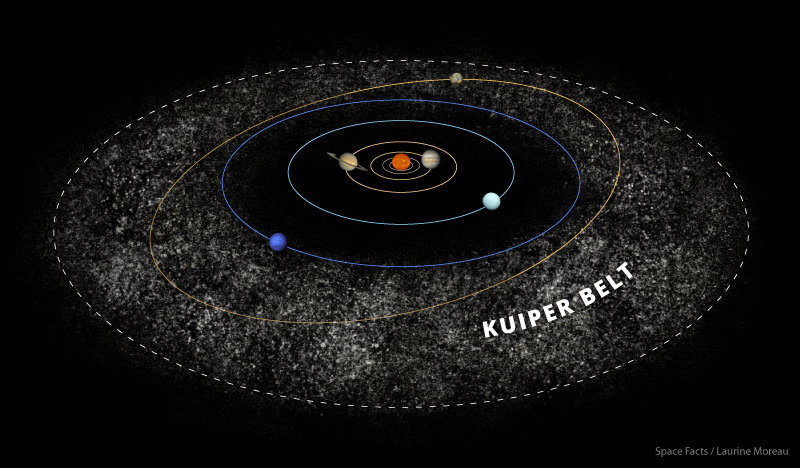
The outer reaches of the Solar System constitute a strange and mysterious place. Out past the orbit of Neptune, where it’s cold and dark, a swarm of icy objects called the Kuiper Belt orbits the Sun, thought to be more or less unchanged since the Solar System was born.
Because it’s so dark and far away, and the objects so small, it’s hard for astronomers to discern what exactly is out there. This makes the results of a recent search quite marvelous. Using data from the Dark Energy Survey, astronomers identified 815 trans-Neptunian objects (TNOs), of which 461 are newly discovered.
This is a significant bump to the 3,000 or so known TNOs in the outer Solar System, information that could help us better model how the Solar System formed, and maybe even search for the elusive Planet Nine.
“This catalog has 817 confirmed objects (461 first discovered in this work),” the researchers wrote in their new paper.
“This is the second largest TNO catalog from a single survey to date, as well as the largest catalog with multi-band photometry.”
The Dark Energy Survey didn’t set out to look for TNOs. It ran between August 2013 and January 2019, collecting 575 nights’ worth of infrared and near-infrared data on the southern sky. The goal was to study a range of objects and phenomena such as supernovae and galaxy clusters to try to calculate the acceleration of expansion of the Universe, thought to be influenced by dark energy.
But the high degree of depth, breadth and precision of the survey turned out to be very good for looking for objects in the distant Solar System as well – beyond Neptune’s orbit at about 30 astronomical units.
Last year, astronomers analyzed those data to find more than 100 new minor planets, a category that includes everything that isn’t a comet or a planet, basically.
The new work, conducted by the same team and using an improved detection pipeline, adds 461 more. The researchers also ran TNO detection simulations, to compare against their results and see if their techniques were accurate.
TNOs retain traces of the dynamics of the early Solar System
This region of space is fascinating. With very little out there to perturb their orbits, astronomers believe that the TNOs retain traces of the dynamics of the early Solar System. During this time, according to current models, the planets were forming and moving around – the system would have looked very different from how it looks today.
As the giant planets maneuvered into their current orbits, their gravitational interactions influenced the orbits of the TNOs. These resulting orbits can be studied to reconstruct the events that made them that way; because clusters of TNOs can have quite different orbits, the more of them we find, the more accurate the reconstruction.
Extreme TNOs boost search for Planet 9
In addition, the orbits of a subset of TNOs are really weird. These are called extreme TNOs, with an average orbital distance (or semi-major axis) greater than 150 astronomical units. Some astronomers believe that extreme TNOs are evidence of something causing a gravitational ruckus out there – the hypothetical Planet Nine.
We’ve not found many of these objects, so every new one adds an additional data point that could help either find or rule out the existence of Planet Nine. The new catalog adds another nine extreme TNOs to the mix, four of which have semi-major axes greater than 230 astronomical units.
Some other amazing discoveries
The researchers also found a number of objects with orbital resonances with Neptune, which is when bodies have orbital periods with a simple ratio; four new Neptune trojans, or asteroids that share the planet’s orbit in gravitationally stable Lagrangian points.
They also discovered a large comet called C/2014 UN271 (Bernardinelli-Bernstein) on a journey inwards towards the Sun (although it will only come as far as Saturn before heading out again)
And a notable “detached” object, so-named because its orbit is not influenced by Neptune, with an extraordinarily high orbital angle from the plane of the Solar System.
All this new information, the researchers said, represents a significant increase in our understanding of the outer Solar System. So far, the Dark Energy Survey’s data has contributed around 20 percent of all known TNOs, which is pretty huge.
“These will be valuable for further detailed statistical tests of formation models for the trans-Neptunian region,” the researchers wrote.
And I am sure we will soon detect Planet 9. [ArXiv, Science Alert]
Now subscribe to this blog to get more amazing news curated just for you right in your inbox on a daily basis (here an example of our new newsletter).
You can also follow us on Facebook and/ or Twitter. And, by the way you can also make a donation through Paypal. Thank you!
You should really subscribe to QFiles. You will get very interesting information about strange events around the world.

Menwhile, I also recommend to subscribe to Galileyo the only Information Distribution Platform that gathers uncensored information and delivers that information to you, regardless of the situation on the ground, via global Satellite Phone Networks.













That’s groovy.
Meanwhile on earth, our feckless leader is playing revenge politics with Texas and Florida. I hope states secede from the satanic union of the biden regime. He’s like hitler with dementia.
Oh, and that stupid cackling witch, the vice prostitute.
????????F ’em both!
https://www.thegatewaypundit.com/2021/09/new-biden-goes-nuclear-republican-governors-healthcare-singles-florida-texas-govs-savage-tweet-slashing-delivery-lifesaving-covid-treatment-states/
https://www.thegatewaypundit.com/2021/09/350000-ballots-disappeared-california-recall-election-tuesday-night-ap-blames-incident-staff-error/
Massive voter fraud again. Impossible. Lol. Lefty ideology is so weak that they have to cheat, in order to ram it down your throat. I hope our state secedes, and all the commies go back to their blue shitholes.
I try and spend as little money with corporate communists too. Once you hear the ad for their businesss, and it promotes leftist ideology, quit ’em. Same with sports and music.